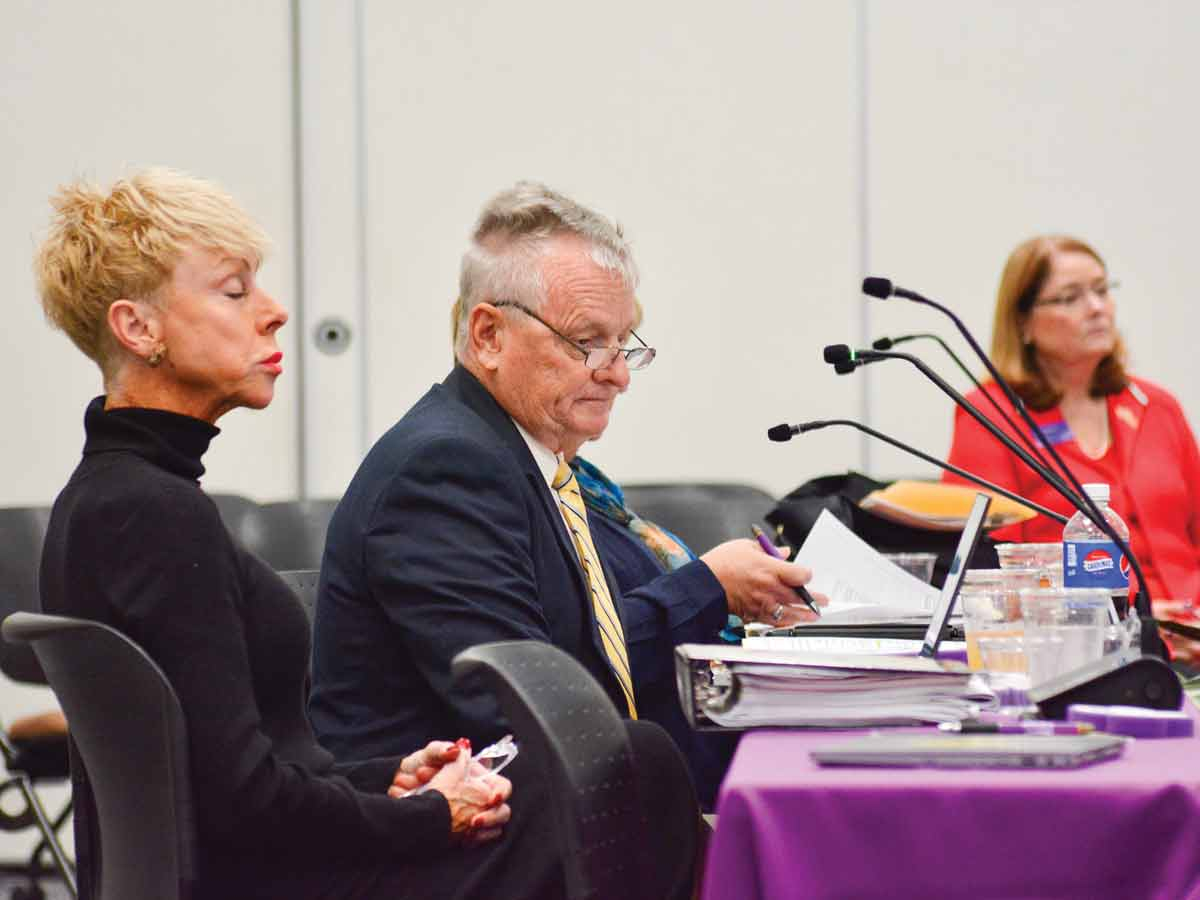NC’s Local Government Commission returns to its roots in Western North Carolina
 State Auditor Beth Wood (left) and Treasurer Dale Folwell (center) review their notes as Chancellor Kelli R. Brown (right) looks on during a Nov. 1 meeting of the Local Government Commission in Cullowhee. Cory Vaillancourt photo
State Auditor Beth Wood (left) and Treasurer Dale Folwell (center) review their notes as Chancellor Kelli R. Brown (right) looks on during a Nov. 1 meeting of the Local Government Commission in Cullowhee. Cory Vaillancourt photo
Although little-known, there’s an agency within the North Carolina Department of State Treasurer that has a tremendous impact on everything from local water quality to municipal property taxes — and it got its start because of a bad situation right here in Western North Carolina, nearly 100 years ago.
“The main function of the Local Government Commission is to be an oversight board for nearly 1,100 entities that want to borrow money,” said Dale Folwell, North Carolina’s state treasurer. “There are 100 counties, 548 cities, water and sewer districts, universities, airport authorities and hospitals, for example.”
Folwell chairs the LGC, which meets monthly to consider a variety of requests from public bodies across the state. The LGC’s board is comprised of Folwell, State Auditor Beth Wood, Secretary of State Elaine Marshall and Secretary of Revenue Ronald Penny, along with five other appointed members. Three of them are appointed by the governor, one by the Senate, and one by the House.
Formed by the General Assembly in 1931, the LGC acts mainly as a financial watchdog to help keep overzealous municipalities out of financial trouble, like Asheville was at that time.
“We’ve been one of only about 13 states that have been able to maintain our triple-A bond rating during the most volatile period in the modern era, and I think part of that is based on the strength of the Local Government Commission,” Folwell said. “It sends a clear message to Standard & Poor’s, Moody’s and Fitch that we’re always focused on trying to figure out what’s right, get it right and keep it right.”
After the stock market crashed in 1929, the subsequent economic downturn hit Asheville hard. Half a dozen banks closed down and the town found itself more than $8 million in debt (equivalent to $156 million today) because of bonds used to pay for infrastructure improvements during the roaring 1920s.
Related Items
That debt hampered Asheville for another 46 years until it was finally paid off on June 30, 1976.
Ironically, the town’s indebtedness may have saved it from becoming another cookie-cutter glass and steel skyscraper town. Funds weren’t readily available for urban renewal, so many deco-style 1920s-era buildings remain today. However, the ignominious distinction of having the highest per-capita debt in the nation wasn’t exactly something for residents to cheer.
Had the LGC been in place at the time, it’s highly likely it would have curbed or quashed some of the runaway borrowing of the previous decade, saving Asheville residents millions in taxes over the ensuing decades.
On Nov. 1, Folwell brought the LGC to Western Carolina University in Cullowhee, where it held only its second meeting ever outside the confines of the state’s capital in Raleigh.
“We met last month in Tyrrell County. It’s one of the lowest income counties in North Carolina, if not the United States, and so we thought that after taking it east, we should also take it west,” he said. “We have citizens here who live closer to four other state capitals than they do to Raleigh. We thought it would be great to bring Raleigh to you for once instead of you having to come to Raleigh.”
The agenda for the meeting was fairly typical, and served as a microcosm of the fiscal and development-related issues facing North Carolina today.
First up was the community of Winnabow, in Brunswick County. Residents there requested that the LGC sign off on its petition to incorporate as a chartered municipality.
But the proposed town would have just 6,700 residents, and commission members expressed concerns about the proposed town’s tax base, lack of fiscal management experience, insufficient knowledge of state statutes governing municipalities and overall viability.
Current challenges, which include finding and paying for qualified staff members and the suite of software products they’d need to operate a municipal government, also weighed heavily against the wannabe town. In the end, the LGC rejected Winnabow’s request, fearing it would just end up on the UAL. The UAL, or unit assistance list, is where public bodies that run afoul of fiscal controls end up, and it’s not a good place to be.
Per statutory authority, the LGC assumes control of local governments or public authorities that can no longer manage their own financial affairs by impounding their books and records. The LGC can levy taxes, expend revenues, adopt budgets or apply other financial controls when needed.
Currently, there are six municipalities on the UAL, and one sanitary district.
The Cliffside Sanitary District, in Rutherford County, was designated as distressed in September, 2019 after it was determined that its sewer system had become too expensive to operate.
Kingstown, in Cleveland County, has been on the list since early in 2020, due to financial reporting issues.
In October, 2021, Cumberland County’s Spring Lake made the list after the elected board allowed the town’s general fund to fall into a deficit.
That same month, Robersonville, in Martin County, was added to the list because it failed to file required audits for three years in a row.
In Wayne County, Pikeville incurred too much debt against too little cash, so it joined the list in April, 2021.
Eureka, also in Wayne County, illegally used unavailable fund balance to balance its sewer fund and has been on the list since 2019.
East Laurinburg, in Scotland County, made the list in November 2021, after the state auditor discovered that town funds had been expended for personal use by the town’s finance officer.
But it’s not all doom and gloom at the LGC; a number of agenda items the commission ended up approving at the meeting show how a growing state and its local governments meet the needs of some of their most vulnerable residents.
The North Carolina Capital Facilities Finance Agency, which provides tax-exempt financing to nonprofits engaged in providing elementary and secondary education, won approval to issue $9.7 million in conduit revenue bonds, which will be lent to Aces for Autism, a nonprofit educational center in Winterville.
Aces for Autism will use the money to create a 32,000 square-foot building on its 24-acre campus that will be used for everything from food service to one-on-one therapy.
The Raleigh Housing Authority was given permission to issue $27 million in conduit revenue bonds, which will be used for affordable housing.
The 4.6-acre project is called Millner Commons, and will transform an old Presbyterian church into 156 units available to people aged 55 and older. All units will be available to people making less than 60% of the area’s median income, with 10% of them reserved for people with incomes less than 30% of the area’s median, and another 10% reserved for people with disabilities or people who were formerly unsheltered.
A similar, much larger project was also approved by the LGC. The North Carolina Medical Care Commission can now issue $105 million in conduit revenue bonds for a 250,000 square-foot addition to The Forest at Duke, a 47-acre independent living retirement community that already has 234 independent living units, 34 assisted living units, and 58 skilled nursing beds.
The need for more housing of this type is evidenced by the fact that 93% of the proposed units are already reserved.
On a more local level, the Town of Waynesville recently appeared before the commission; this past May, the LGC approved Waynesville’s request to borrow $1.9 million to reimburse itself for a land purchase that will serve as the location for a new fire station as well as to purchase a new tanker truck and refinance existing public works building improvement debt.
A number of elected officials and municipal administrators from Western North Carolina turned up to observe the meeting in Cullowhee, including Rep. Karl Gillespie (R-Macon), Rep. Mike Clampitt (R-Swain), Jackson County Commissioner Gayle Woody and Franklin Town Manager Amie Owens, who previously spent eight years in Waynesville government.
“We do have the possibility to appear before this board. We were approved for some financing through the State Revolving Fund for our water treatment facility, our phase two on that,” Owens said. “Unfortunately, once we got the preliminary engineering report, the cost had doubled, so we do have the potential to come back and request additional funds through the SRF.”
Owens said she was using the Cullowhee meeting as an opportunity to learn more about the LGC in the event her government needs to make a request in the future.
“It was valuable because we need to know what the LGC is looking for related to information that we can provide for them or the data they can use to make their decision, so that we know exactly what they need so that we’re not stumbling around and having elongated conversations,” she said. “We just need to be succinct and have all of our information together before we get here.”









